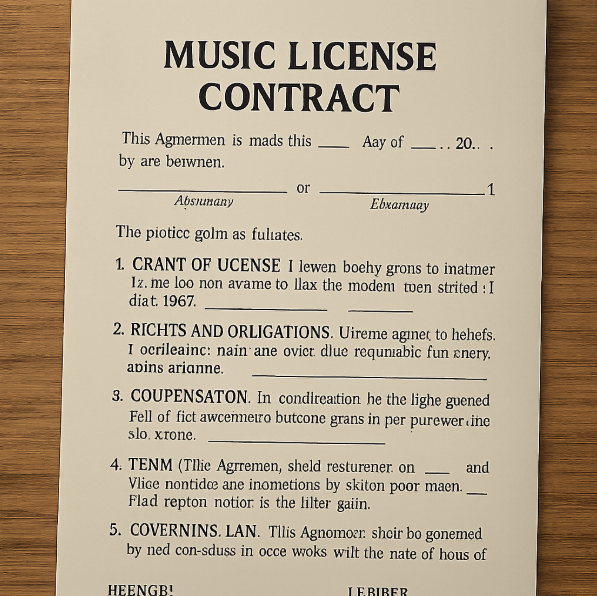Music has become an integral part of our digital interactions, from social media platforms to mobile applications. This ubiquity means that understanding the intricacies of music copyright can no longer be left to legal teams alone. Every stakeholder, from marketing to product development, must be aware of how music rights impact their work. This knowledge aids in avoiding legal pitfalls and ensures that music usage aligns with the company’s ethical and strategic goals.
Music copyright is a legal framework that protects the intellectual property rights of creators. It ensures that songwriters, composers, and musicians receive compensation for the use of their work. In a world where digital access to music is at an all-time high, maintaining the integrity of music copyright is more important than ever. With the digital age continuing to expand the avenues for music distribution and consumption, understanding the costs associated with music copyright becomes increasingly important for maintaining compliance and fostering innovation.
The digital transformation has revolutionized how music is created, shared, and consumed. Platforms like Spotify, Apple Music, and YouTube have made it easier than ever to access vast libraries of music. However, they also complicate the landscape of music copyright, requiring businesses to navigate complex licensing agreements and ensure they are compensating artists fairly. This complexity calls for a robust understanding of copyright laws and an awareness of how digital platforms impact these regulations.
What Are Music Copyright Costs?
Music copyright costs encompass various fees that must be paid to legally use music. These fees can vary greatly depending on the type of use, the length of the music, and the specific rights being licensed. Understanding these costs is crucial for businesses that wish to incorporate music into their operations without infringing on creators’ rights. Commonly, these costs are divided into two main categories: mechanical licenses and performance licenses.
Music copyright costs are not just a financial consideration; they represent a critical aspect of ethical business practices. By understanding the costs involved, businesses can ensure they are supporting artists and contributing to a fair and sustainable music industry. This responsibility extends beyond legal compliance, reflecting a company’s commitment to ethical standards and social responsibility.
Mechanical Licenses
A mechanical license is required whenever a song is reproduced, whether on a physical medium like a CD or through digital downloads and streaming. The cost of a mechanical license is typically a statutory rate, which in the United States is set by the Copyright Royalty Board. This ensures that creators are fairly compensated for each reproduction of their work, which is crucial in an era where streaming services dominate the music landscape.
The statutory rate for mechanical licenses provides a baseline for negotiations but can vary based on factors such as the medium of distribution and the scale of reproduction. Businesses must be diligent in understanding these nuances to ensure they are in compliance with copyright laws while also managing costs effectively. This diligence not only protects businesses from legal repercussions but also strengthens their reputation as responsible users of intellectual property.
Performance Licenses
Performance licenses are necessary for any public performance of music, whether live or recorded. This includes music played in businesses, during events, or on streaming platforms. Performance rights organizations (PROs) such as ASCAP, BMI, and SESAC manage these licenses and collect fees on behalf of the rights holders. These organizations simplify the process of obtaining performance licenses by offering blanket licenses that cover multiple uses, providing flexibility for businesses of all sizes.
The role of PROs is crucial in streamlining the licensing process, allowing businesses to focus on creative and strategic objectives rather than getting bogged down in legal complexities. By working with PROs, businesses can ensure that their use of music is both legal and ethical, supporting artists while enhancing their own offerings. This relationship between businesses and PROs is symbiotic, fostering innovation and ensuring the sustainability of the music industry.
Music Licensing Fees

Music licensing fees are payments made to secure the right to use music in various contexts. These fees can be complex and vary significantly based on several factors including the type of media, the audience size, and the duration of use. Understanding these variables is essential for businesses to effectively budget for music use and to maximize the value derived from their investment in music.
The complexity of music licensing fees reflects the diverse ways in which music is used across industries. From advertising to entertainment, each sector has unique requirements and challenges that influence licensing costs. By understanding these nuances, businesses can tailor their music strategies to align with their specific goals and industry standards.
Factors Influencing Music Licensing Fees
- Type of Use: The way music is used significantly impacts the cost. For instance, using a song in a commercial typically incurs higher fees than playing it in a small café. This is because commercial uses often reach a larger audience and have a direct impact on consumer behavior, necessitating higher compensation for the artists.
- Audience Size: Larger audiences typically mean higher fees. A song played in a stadium will cost more than the same song played in a small local venue. This reflects the broader reach and potential impact of the music, requiring fair compensation for its creators.
- Duration and Territory: The length of time the music will be used and the geographical regions it will be available in can also affect the fees. Long-term use or international distribution often requires higher fees to account for the extended exposure and potential revenue generation.
- Media Platform: Different platforms have varying licensing structures. For example, streaming platforms may negotiate different rates compared to traditional broadcast media. Understanding these distinctions is vital for businesses to navigate the licensing landscape efficiently.
Copyright Costs for Specific Artists
Specific artists, such as Kate Bush, may have different licensing costs based on their popularity and the uniqueness of their work. Using music from well-known artists often requires negotiation and can result in higher fees due to their market value. The distinctiveness of an artist’s work can elevate its market value, making it a premium choice for businesses looking to make a significant impact.
Negotiating copyright costs for specific artists involves understanding not just the financial implications, but also the strategic value of associating with well-known music. Businesses must weigh these considerations carefully, balancing the potential benefits of using high-profile music against the costs involved. This strategic approach ensures that music use enhances brand value and resonates with the target audience.
Navigating Music Copyright for Business Strategy

For business leaders, understanding music copyright is not just about compliance; it’s about leveraging music strategically to enhance business operations and innovate. Music can be a powerful tool for branding, customer engagement, and even product development, offering unique opportunities for differentiation and market leadership.
By integrating music thoughtfully into business strategies, companies can create memorable experiences that resonate with their audiences. This requires a deep understanding of music copyright, as well as a willingness to explore creative solutions that align with business goals. Through strategic music use, businesses can not only comply with legal requirements but also gain a competitive edge in their industry.
Aligning Music Use with Business Goals
Incorporating music into your business can improve customer experience, boost brand identity, and create new revenue streams. To align music use with business goals, consider the following:
- Identify Strategic Opportunities: Look for ways music can enhance your business offerings, such as integrating licensed music into apps or creating branded playlists. These strategies can enhance user engagement and foster a deeper connection with your brand.
- Evaluate Costs and Benefits: Assess the potential return on investment for music use. Weigh the costs against the expected benefits to make informed decisions. This evaluation helps in prioritizing music initiatives that offer the greatest strategic value.
- Collaborate with Legal and Creative Teams: Work closely with legal experts to navigate licensing requirements and with creative teams to ensure music aligns with your brand. This collaboration ensures that music use is both compliant and creatively impactful, supporting broader business objectives.
- Leverage Analytics and Feedback: Utilize data analytics to measure the impact of music on customer behavior and brand perception. This insight can guide future music strategies and optimize investment in music-related initiatives.
Challenges and Solutions in Music Licensing
While music licensing offers opportunities, it also presents challenges. Here are some common issues and potential solutions:
- Complex Licensing Processes: Simplify the process by working with experienced licensing agencies or consultants who understand the intricacies of music rights. These experts can navigate the legal landscape efficiently, ensuring compliance and cost-effectiveness.
- Budget Constraints: Consider alternative licensing options such as royalty-free music or negotiating blanket licenses that cover multiple uses. These options can reduce costs while still providing access to quality music.
- Evolving Technology: Stay informed about new technologies that affect music distribution and consumption, such as blockchain for rights management, to stay ahead in the industry. Embracing technological advancements can streamline licensing processes and improve transparency in rights management.
- International Licensing: Navigating the complexities of international licensing requires understanding the specific regulations and market conditions in each territory. Partnering with local experts can facilitate smoother licensing processes and ensure global compliance.
Future Trends in Music Copyright
The landscape of music copyright is continually evolving, influenced by technological advancements and changes in consumer behavior. Here are some trends to watch:
- Digital Transformation: The shift towards digital platforms continues to reshape music licensing. Understanding the implications of streaming services and digital downloads is critical. As consumption patterns change, businesses must adapt their licensing strategies to remain relevant and compliant.
- Blockchain and Smart Contracts: These technologies promise to streamline rights management and ensure more transparent and efficient royalty payments. By automating and securing transactions, blockchain can revolutionize how music rights are managed and monetized.
- Artificial Intelligence: AI is changing how music is created and distributed, raising new questions about copyright and licensing. As AI-generated music becomes more prevalent, businesses must navigate the legal implications and ethical considerations of using such content.
- User-Generated Content: With the rise of platforms encouraging user-generated content, understanding the copyright implications of music used in user-created videos and streams is crucial. Businesses must develop strategies to manage rights and ensure compliance in this dynamic environment.
Conclusion
Understanding music copyright costs is essential for any business leveraging music as part of its strategy. By navigating the complexities of music licensing, businesses can enhance their offerings, comply with legal requirements, and stay competitive in a rapidly changing digital landscape. Music copyright isn’t just a legal necessity; it’s a strategic tool for innovation and growth.
As you explore the potential of music in your business, consider both the costs and opportunities that come with it. By doing so, you can ensure that your use of music not only complies with legal standards but also aligns with and supports your broader business objectives. This strategic approach to music use fosters innovation, enhances brand value, and positions your business for long-term success in an increasingly music-driven market.




